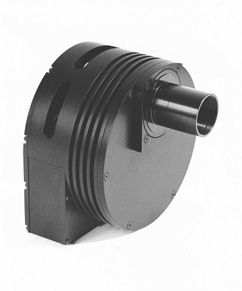 |
ST-9XE CCD Imaging Camera |
| CCD Imaging Cameras | ST-402ME | ST-7XE | ST-8XE | ST-9XE | ST-10XE | ST-2000XM | NEW Large Format Cameras | |
| Video Camera / Autoguider |
|
|||||||
| Industrial / Scientific | ||||||||
MODEL ST-9XE |
 |
ST-9XE CCD Imaging Camera |
![]() January 9, 2004: We are now offering two
models of ST-9-XE cameras. Click here for more details.
January 9, 2004: We are now offering two
models of ST-9-XE cameras. Click here for more details.
The ST-9XE is identical to the ST-8XE cameras with the exception of the imaging CCD. The ST-9XE utilizes the same patented dual sensor head design integrating one CCD for self-guiding and another CCD for imaging. In the case of the ST-9XE the imaging sensor is the new Enhanced KAF-0261E detector from Kodak with 512 x 512 pixels at 20 microns square. The ST-9XE Imaging Camera is ideal for use on long focal length scopes where a larger field of view than an ST-7XE is desired, but one's budget does not allow for an ST-8XE camera. Large scopes, even those with relatively fast f/ratios, have focal lengths that "waste" sensitivity of cameras using detectors with small pixels. Longer focal lengths also mean smaller fields of view given a fixed detector size. Take, for example, a C-14 at f/7, 16" SCT at f/6.3 and a 20" f/5. In all of these cases the telescopes have focal lengths of about 98 to 100 inches. When used at 100 inches of focal length, the 9 micron pixels of the ST-7XE and ST-8XE cameras subtend about 0.7 arcseconds - a bit small for this focal length under average seeing conditions. So these cameras are often operated binned 2x2 at focal lengths of 100 inches or more unless the optics and seeing are rather exceptional. For the ST-8XE this is no problem because the detector has 1.5 million pixels and binning 2x2 still leaves the user with a reasonable 765 x 510 pixels @ 18 microns. But binning the ST-7XE 2x2 yields an image that is 382 x 255 so the image size on the monitor begins to get small for this size camera. However, the ST-9XE's 20 micron pixels subtend about 1.6 arcseconds per pixel at 100 inches focal length without binning. Just about perfect for optimum sensitivity under typical seeing conditions. This gives the long focal length user the advantage of larger more sensitive pixels and a reasonably large image of 512 x 512 at a substantial savings compared to an ST-8XE. Moreover, the FOV of the ST-9XE is nearly as large as an ST-8XE. Click here for more information on recent improvements in design and the new High Speed USB Interface
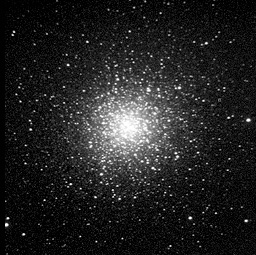 |
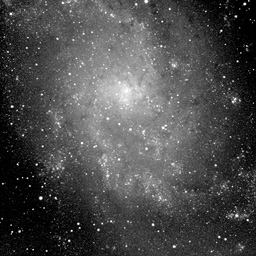 |
| M13. ST-9E
prototype First Light: a single 120 second cropped image taken through a 10" f/6.3 SCT (1/4 size). Michael Barber / SBIG |
M33. ST-9E
production First Light: a single 360 second image taken through a 12" SCT at f/6.3. Courtesy Gary Hug |
Sensitivity:
With its relatively large (20 micron) pixels, the ST-9XE
is approximately 20 times as sensitive as a standard ST-7XE ABG camera (binned 1x1) with a
field of view approximately 3.3x as large as the ST-7XE. This compares very
favorably with an ST-8XE operating in 2x2 binned mode at about half the cost of the
ST-8XE. So for long focal lengths where one cannot take advantage of the smaller
pixels of the ST-7XE or ST-8XE, the ST-9XE is an excellent choice
 |
Relative Intensities |
ST-8 ABG |
ST-8E ABG |
ST-9E NABG |
| (A) Background | 1 | 1.3 | 14.2 | |
| (B) Star peak (color unknown) |
1 | 2.0 | 13.7 | |
| (C), (D) H-a regions | 1 | 2.2 | 18.4 | |
| (E) OIII bright (~50% above background) |
1 | 2.1 | 25.0 | |
| (F) OIII faint (>10% above background) |
1 | 1.5 | 20.0 | |
| M27. LRGB color image for reference only by Robert Dalby |
Field of View:
The image and diagram below demonstrates the larger field
of view one obtains with the ST-9XE detector compared to the ST-7XE. Note this has
nothing to do with the number of pixels on the detector or how the image is displayed on
your computer monitor. Rather, it is strictly based on the overall size of the
detector.
 |
Relative CCD szes |
The ST-9XE is an excellent choice for minor planet and
supernova searches when one’s budget does not allow for a very large CCD camera such
as the KAF-1001E based ST-1001E camera. Moreover, the ST-9XE is capable of
self-guiding with a built-in TC237 tracking CCD. It is therefore capable of hour
long self-guided exposures for deep space imaging. The ST-9XE accepts all of the
same accessories as the ST-7XE and ST-8XE cameras including the integrated CFW8A color
filter wheel for color imaging or UBVRI photometric measurements, AO-7 adaptive optics
device, CLA7 camera lens adapter, etc.
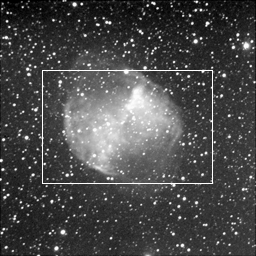 |
Full frame is the field of view of the
ST-9XE at 110 inches focal length. The area inside the white box is the field of view of the ST-7XE at the same focal length. |
One month after taking delivery of one of our first production ST-9E cameras, two amateurs, Gary Hug and Graham Bell, discovered a ~19th magnitude comet: Comet P/1999 X1 Hug-Bell. With a single exception we are informed that this is the faintest comet ever discovered by an amateur astronomer. Gary and Graham were using a 12" SCT at f/6.3. The discovery was made while blinking 6 minute exposures taken in search of an asteroid. Subsequent 10 minute and 20 minute exposures revealed the comet's tail.
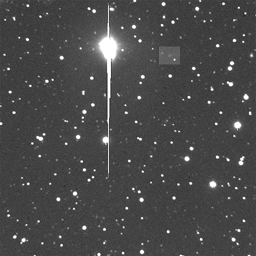 |
Discovery image (reduced) with comet
P/1999 X1 Hug-Bell in the highlighted box. Gary Hug writes: "The comet (P/1999 X1 Hug-Bell) was discovered Dec 10th and has been published in the IAU Circular #7331. Orbital information shows this comet to orbit between Mars and just outside Jupiter's orbit although some distance above the giant planet's path. It's currently about magnitude 18.5, located near the beehive cluster, and was magnitude 18.8 at discovery. The comet will maintain a near even brightness for the next few weeks then gradually fade. It's period is 7.01 yrs. |
Model ST-9XE
Typical Specifications
CCD Specifications:
| CCD | Kodak Enhanced KAF-0261E (Class 1) + Texas Instruments TC-237 |
|---|---|
| Pixel Array | 512 x 512 pixels, 10.2 x 10.2 mm |
| Total Pixels | 262,144 |
| Pixel Size | 20 x 20 microns |
| Full Well Capacity | 150,000 e- |
| Dark Current | 4e¯/pixel/sec at 0° C |
| Antiblooming | Non-ABG only |
Readout Specifications
| Shutter | Electromechanical |
|---|---|
| Exposure | 0.11 to 3600 seconds, 10ms resolution |
| Correlated Double Sampling | Yes |
| A/D Converter | 16 bits |
| A/D Gain | 2.2e¯/ADU |
| Read Noise | 15e¯ RMS |
| Binning Modes | 1 x 1, 2 x 2, 3 x 3 |
| Full Frame Acquisition (including digitization and download) with high speed USB interface |
< 1 second |
Optical Specifications (8" f/10)
| Field of View | 17.3 x 17.3 arcminutes |
|---|---|
| Pixel Size | 2 x 2 arcseconds |
System Specifications
| Cooling - standard | Single Stage Thermoelectric
Active Fan Water Assist Ready -45 degrees C from Ambient Typical |
|---|---|
| Temperature Regulation | ±0.1°C |
| Power | 5 VDC at 1.5 amps, ±12 VDC at
0.5 amp -------------------------------- 110VAC desktop power supply included -------------------------------- 12VDC power supply optional |
| Computer Interface | USB |
| Computer Compatibility | Windows 98/2000/Me/NT/XP |
| Guiding | Dual CCD Self-Guiding |
Physical Dimensions
| Optical Head | 5 inches diameter x 3 inches 12.5 cm diameter x 7.5 deep 2 pounds/0.9 Kg |
|---|---|
| CPU | All electronics integrated into Optical Head, No CPU |
| Mounting | T-Thread, 1.25" and 2" nosepieces included |
| Backfocus | Approximately 0.9 inches 2.3 cm |
Price
Price and specifications are subject to change without notice
Revised: February 10, 2005 03:09:01 PM.
Copyright © 1998 Santa Barbara Instrument Group, Inc. All rights reserved.
Please report any problems with this page directly to the Webmaster